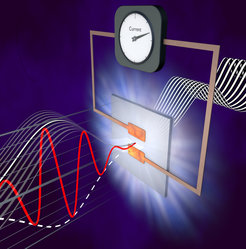Speeding up digital performance using engineered light
In an experiment carried out at MPQ, the fastest ever switching of electric currents in semiconductors has been achieved with few-cycle laser pulses.

The work, published in Optica, found that electric current can be turned on and off in a semiconductor (gallium nitride in this case) at unprecedented speeds by using engineered light as a means of control. These findings pave the way for the design of optically controlled semiconductor electronic devices that can operate at frequencies much larger than those demonstrated until now.
“The time it takes to switch electric current on and off in a semiconductor, determines the rate at which electronic devices can perform. We found that by using few-cycles laser pulses with engineered optical field waveforms – which are the fastest tools available to researchers – electric current can be controlled in a semiconductor at rates thousands of times higher than those achieved in state-of-the-art electronics,” said Monash researcher and ARC Future Fellow, Dr. Agustin Schiffrin, the lead investigator of the study.
“We successfully investigated how these devices operate in various regimes by comparing the circuits with two different materials: gallium nitride and fused silica. In both cases, laser field induces interference of electronic excitations and allows controlling them on a femtosecond timescale. Our current setup performs at much lower field intensities than those required for dielectrics, so it can work even with non-amplified laser pulse sources,” said Dr. Stanislav Kruchinin, a researcher from MPQ.
This work showcases the fastest control of electric currents ever measured in a semiconductor, opening the door to the design of novel optically controlled electronics.












